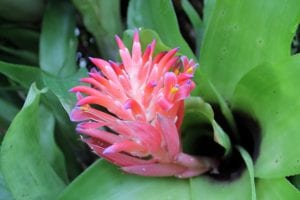Plants in this display are grown both outdoors and under glass. In the warm temperate zone cacti Echinocactus grusoni and Cleistocactus hyalacanthus from the Americas and the sub-tropical succulents, Euphorbia grandidens and Sarcostemma viminale from South Africa are two examples of convergent evolution’ with stem succulents adapted to a seasonally dry environment.

In the sub-tropical zone orchids, ferns and bromeliads grow as ‘epiphytes’ on the branches of forest trees illustrating some of the rich diversity of plant communities to be found in the canopy of sub-tropical and tropical forests. Carnivorous plants, found worldwide, have evolved strategies to catch and digest insects. In the warm temperate zone the sticky-leaved Drosera capensis and quickly acting venus fly trap, Dionaea muscipula trap insects with sticky leaves and movement. In the sub-tropical and tropical zones the pitcher plants Nepenthes x masteriana and N. truncata produce large liquid-filled pitchers each with glistening sugar deposits as attractants to flies that are enticed into the pitcher only to fall and drown. These and many other carnivorous plants are grown illustrating plants adaptations to trap and digest animals to supplement their nutrient diet when growing on poor soils.

Many orchids are displayed, some with swollen psuedobulbs, a useful adaptation to storing food and water enabling some orchids to grow as epiphytes on the branches of trees in the sub-tropics and tropics. These grow alongside bromeliads whose interlocking leathery leaves form ‘vases’ which trap rainwater. The resulting pools attract insect and other animal life whose waste contributes to a nutrient rich pool from which the plant is able to absorb nutrients. Tropical plants like anthurium’s and cycads with hard, evergreen polished leaves, each with a terminal ‘drip tip’, have adapted to the humid wet environments to ensure their leaf surfaces keep dry and avoid a build up of algae and moss.

